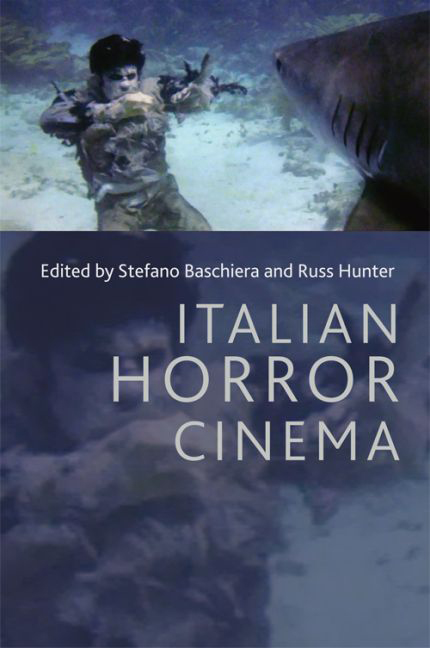Book contents
- Frontmatter
- Contents
- List of figures
- List of contributors
- Acknowledgements
- Introduction
- 1 Preferisco l'inferno: early Italian horror cinema
- 2 Domestic films made for export: modes of production of the 1960s Italian horror film
- 3 The 1980s Italian horror cinema of imitation: the good, the ugly and the sequel
- 4 Knowing the unknown beyond: ‘Italianate’ and ‘Italian’ horror cinema in the twenty-first century
- 5 Bavaesque: the making of Mario Bava as Italian horror auteur
- 6 The Argento Syndrome: aesthetics of horror
- 7 Scrap metal, stains, clogged drains: Argento's refuse and its refusals
- 8 The giallo /slasher landscape: Ecologia del delitto, Friday the 13th and subtractive spectatorship
- 9 Kings of terror, geniuses of crime: giallo cinema and fumetti neri
- 10 Political memory in the Italian hinterland: locating the ‘rural giallo’
- 11 The horror of progressive rock: Goblin and horror soundtracks
- 12 ‘The only monsters here are the filmmakers’: animal cruelty and death in Italian cannibal films
- 13 Italian horror cinema and Italian film journals of the 1970s
- Index
11 - The horror of progressive rock: Goblin and horror soundtracks
Published online by Cambridge University Press: 12 September 2017
- Frontmatter
- Contents
- List of figures
- List of contributors
- Acknowledgements
- Introduction
- 1 Preferisco l'inferno: early Italian horror cinema
- 2 Domestic films made for export: modes of production of the 1960s Italian horror film
- 3 The 1980s Italian horror cinema of imitation: the good, the ugly and the sequel
- 4 Knowing the unknown beyond: ‘Italianate’ and ‘Italian’ horror cinema in the twenty-first century
- 5 Bavaesque: the making of Mario Bava as Italian horror auteur
- 6 The Argento Syndrome: aesthetics of horror
- 7 Scrap metal, stains, clogged drains: Argento's refuse and its refusals
- 8 The giallo /slasher landscape: Ecologia del delitto, Friday the 13th and subtractive spectatorship
- 9 Kings of terror, geniuses of crime: giallo cinema and fumetti neri
- 10 Political memory in the Italian hinterland: locating the ‘rural giallo’
- 11 The horror of progressive rock: Goblin and horror soundtracks
- 12 ‘The only monsters here are the filmmakers’: animal cruelty and death in Italian cannibal films
- 13 Italian horror cinema and Italian film journals of the 1970s
- Index
Summary
Audio is perhaps the most vital component in the construction of horror films; from the child's lullaby in Profondo rosso/Deep Red (Dario Argento, 1975), Bernard Herrmann's use of stingers in Psycho (Alfred Hitchcock, 1960), to the musique concrète of The Texas Chainsaw Massacre (Tobe Hooper, 1974), the canon of great horror films are inextricably tied and indebted to their soundtracks. And yet despite the importance of this audio-visual synchronicity, Italian horror soundtracks in particular have endured not only as part of the films they were made to complement, but also independently of them. With Goblin embarking on their first US tour as a band as late as 2013, to being sampled by contemporary electronic and hip hop acts such as Justice and Madlib, the work of Goblin and other composers such as Fabio Frizzi has received a continued level of interest both with and without the context of their accompanying images. But perhaps this independence always existed? While the enduring legacy and influence of Italian horror film music is in itself evidence of how these soundtracks contained a quality that allowed them to also exist as popular music, I would propose that it is this same quality, this standalone nature, that makes them notable even at the point of ‘viewing’. Drawing influence from popular music rather than filmic conventions, Italian horror soundtracks (following on from experimentations in Euro Crime) not only liberated themselves from the structural confines of visual editing, they imposed a structure of their own. In analysing their sectional construction or ‘pop music’ approach to film composition I look not only to describe the legacy of their popularity sans visuals, but more importantly to define how this perceived detachment plays a vital role in shaping the experience of the films themselves.
Horror soundtracks often function on a strict synchronicity with the events unfolding onscreen. In more unkind terms, films within the genre are often accused of ‘mickey-mousing’ (Malsky, 2008: 111), a practice that relies on well-worn codes and audio reinforcement to synthesise a reaction rather than one that is seen to be achieved ‘fairly’, that is to say visually (Greene, 2010: 53).
- Type
- Chapter
- Information
- Italian Horror Cinema , pp. 175 - 190Publisher: Edinburgh University PressPrint publication year: 2016



